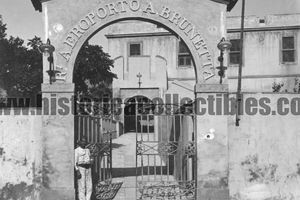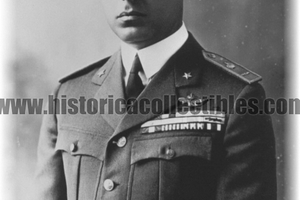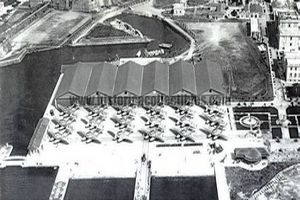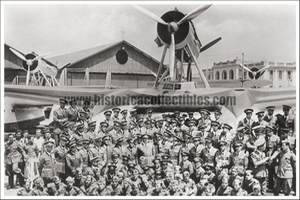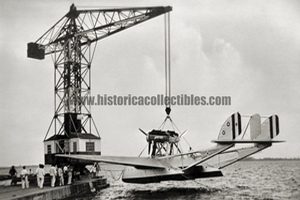Wall Clock E. Boselli, "A. Brunetta Airport - Orbetello", Idroscalo Trasvolatori Atlantici, 1930
Large wall clock, produced by the E. Boselli company - Milan in 1930, for the A. Brunetta airport in Orbetello (Italy), or the Idroscalo from which the Atlantic fliers set off for their legendary exploits.
Considering its particular elegance, with the specific wording of assignment to the airport placed on the dial, it is considered correct to say that this watch was part of the furnishings inside an office in the command or officers' building.
The clock, made of nickel-plated brass, features an 8-day manual winding mechanical movement and the dimensions of the case are over 30 cm in diameter.
Excellent condition and fully functional.
The Orbetello seaplane base was built at the beginning of the 20th century, in the years preceding the First World War, commissioned by the Royal Navy, when Naval Aviation was born in 1913. The initial installation was placed along the shore of the central arm of the Levante lagoon, which presented more favorable environmental situations than that of the Ponente.
In the original installation of the Royal Navy, the airport facility began to take shape on the eastern lagoon. This facility consisted of six contiguous hangars, aprons, slides and landing stages. It was the home of a pilot school and from 1 July 1918 of the 285th Squadron.
In 1925 it was acquired by the Regia Aeronautica to be home to a maritime bombing group. It was named after the aviator ensign Agostino Brunetta. Subsequently, after the acquisition by the Air Force Commissariat, the seaplane base was expanded.
In 1928, the seaplane base constituted the departure and arrival base of the Western Mediterranean cruise, which, with a route of approximately 2800 km, passed through the cities of Cagliari, Pollenza (Balearic Islands), Los Alcazares (Cartagena), Port Alfaques (Tortosa), Berre (Marseille), and finally Orbetello. This cruise was made up of an air brigade of two flocks of Savoia-Marchetti S.59 bis single-engine planes, and a special group of Savoia-Marchetti S.55 high-altitude seaplanes (61 airplanes in total). Italo Balbo, then undersecretary of the Air Force, took part in this Mediterranean cruise.
In 1929 the Eastern Mediterranean cruise was set up, which left from Taranto and then continued towards Athens, Istanbul, Varna, Odessa, Constance, and saw Orbetello as the final stop on the return; on this occasion the total distance was approximately 4,600 km. The flight formation included a wing made up of three groups with five squadrons (for a total of 35 seaplanes); Colonel Aldo Pellegrini was in command of the unit. The then deputy chief of staff, General Francesco De Pinedo, the organizer, also participated in the cruise.
The 93rd Group was established in Orbetello on 1 January 1930, to which in 1933 the 31st Wing would be added, initially called the "Experimental Maritime Bombardment Wing" with SIAI S.55X seaplanes. On 17 December 1930, 14 S55 seaplanes with 56 crew members commanded by Italo Balbo, then Minister of the Air Force, and Giuseppe Valle, chief of staff of the armed force, left Orbetello to carry out the first Atlantic cruise. This crossing included various stops along the entire route such as Cartagena, Kenitra, Villa Cisneros, Bolama, Port Natal, Bahia, and Rio de Janeiro as the final destination.
In 1932, six raids of mass flight exercises were carried out from the Agostino Brunetta airport in the skies of the peninsula.
With the provision relating to order sheet no. 11, dated 15 April 1931, of the Ministry of Aeronautics, the training activity of high-altitude flight personnel received institutional recognition and the NADAM School was also formally recognized ( High seas air navigation). The command of this school was assumed by Gen. of the Aldo Pellegrini air brigade. Teaching in this school was later recognized as university in nature. The plant was completed in 1933, with the settlement including buildings for approximately 80,000 m³, plus sheds for a further 3,000 m³. Also in 1933, the Tenth Anniversary air cruise took off from the airport.
At the end of the 1930s two hangars were built. The task, with a competitive tender, was assigned to Pier Luigi Nervi and they were completed in 1940. Meanwhile, in 1939 the 31st wing was equipped with the CANT Z.506. At the outbreak of the Second World War the 31st wing from Orbetello was transferred to Cagliari Elmas.
In 1942 the Orbetello seaplane base was dedicated to Italo Balbo two years after he, having shot down the plane he was traveling on, died in the skies of Tobruk, Libya, as the Italo Balbo Royal Airport, returning to its original dedication to Brunetta at the end of the war . During the Second World War, the town of Orbetello was the subject of Allied air raids. In July 1943, with the Allied landing in Sicily, the seaplanes of the 85th Group, stationed at the Marsala Stagnone seaplane base, were transferred to Orbetello, until they were disbanded. After 8 September 1943 it was used by the German Luftwaffe. It was these who, when they retreated in 1944, destroyed the main buildings of the seaplane base. Among the works that were demolished were the hangars designed by Pier Luigi Nervi. Until the end of the war it was then used by the Americans for the Twelfth Air Force.
Today, near the seaplane base, there is the Atlantic cemetery, a shrine where many of the protagonists of these enterprises rest.



